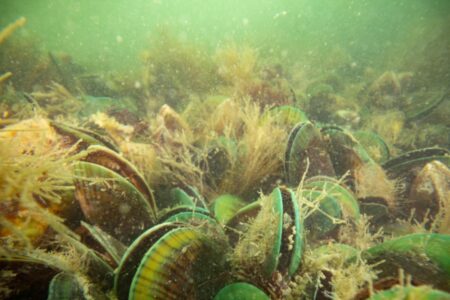
They’re tiny – invisible to the naked eye – and they may hold the missing piece to an environmental puzzle in Auckland’s blue backyard.
Tens of thousands of spat or baby mussels have been making their way in a chilly-bin from a commercial hatchery in Nelson to Sea Life Kelly Tarlton’s Aquarium – for a new life in the big city.
Their mission? To help restore Tīkapa Moana / Te Moananui-ā-Toi – the Hauraki Gulf – back to its former abundance, says Katina Conomos, executive director of Revive our Gulf.
“Right now, the bottom of the gulf in large parts is a sludgy, gloopy mess of mud and sediment. Ask any diver,” says Conomos.
“It wasn’t always like that – at the turn of the 20th Century the inner Hauraki Gulf was carpeted with over 600 sq km of mussel beds – the equivalent of 80,000 rugby fields.
“Last century, the humans started dredging the beds to harvest mussels to eat. That peaked in the 50s and 60s. Amazingly, we ate the lot, without understanding the consequences.”
Conomos says mussels/kūtai are ecosystem heroes. “They clean the seawater, provide structure, protection and accommodate baby fish, species like tāmure/snapper so sought after as kai moana,” she says.
“Without kūtai beds, and along with other pressures resulting from our burgeoning biggest metropolis, the marine ecosystem of the Hauraki Gulf took a big hit. Revive our Gulf is trying to re-mussel Tīkapa Moana.
“So far we’ve deployed 370 tonnes of kūtai in two experimental projects around the gulf.
“We have iwi and scientists, conservationists and volunteers working hard to try and figure out how we can do this at scale.
“What’s obvious is that we need to enable nature to get in behind our efforts, to bring back the mauri, the essence of this magical stretch of water.
“And that’s where these little guys, the mussel spat, come in… these tiny underwater fledglings that float around, eventually making shells and growing into kūtai.
“One of the deep scientific mysteries of this mahi is why the kūtai haven’t come back naturally on their own, after almost being wiped out entirely last century, despite all the mussel farms dotted around the gulf.”
Conomos believes it could have something to do with the spat.
“We know there are mussel spat in the Hauraki Gulf – but it seems that generally, they won’t settle in significant numbers and if they don’t settle down and start a community, there are no mussel reefs,” Conomos says.
“Understanding their reluctance to put down roots, and growing into kutai, is a vital part of the restoration puzzle. Seaweed is one of the places spat latch onto. And that might provide us with a clue.
Revive our Gulf has teamed up with Kelly Tarlton’s Marine Wildlife Trust and the Institute of Marine Science at the University of Auckland to learn more about the relationship between seaweed and spat.
Over the next few months researchers will try and find out if there’s a particular type of seaweed that might entice the spat to start a community on the ocean floor.
“If we find out the sort of home they prefer, then we can build them a place to stay,” says Conomos.
“Taking us one step closer to re-musseling Tīkapa Moana. And that’ll be great for everyone.”










